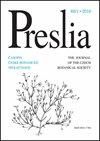Vegetation of temperate inland salt marshes on their north-western border (North German Plain)
IF 4.4
2区 生物学
Q1 PLANT SCIENCES
引用次数: 1
Abstract
Temperate inland salt marshes, formerly used as meadows or pastures, are priority habitats in Europe and are threatened by intensifying anthropogenic activities. They are particularly important because of their biogeographical location on the North German Plain, which is the westernmost hotspot of continental halophytic vegetation in Eurasia. In spite of their remarkably long history of floristic research, there are disproportionately few studies dealing with plant communities. They are traditionally included in the Puccinellion maritimae and Armerion maritimae alliances with a typical distribution along the North and Baltic Sea coasts. The similarity with other inland salt marshes has been overlooked. We surveyed natural and secondary sites with euhalophytic vegetation in central Germany (Saxony-Anhalt and Thuringia) in 2018 and 2020 and analysed 105 phytosociological relevés. This resulted in the identification of three main groups (alliances) containing seven associations: annual hypersaline succulent communities of the alliance Therosalicornion (Salicornietum europaeae, Halimioni pedunculatae-Puccinellietum distantis, Suaedetum maritimae), wet saline meadows of the alliance Juncion gerardi (Triglochino maritimae-Glaucetum maritimae, Scorzonero parviflorae-Juncetum gerardi variant with Glaux maritima) and saline short-grass swards of the alliance Puccinellion limosae (Puccinellietum limosae, Atriplex prostrata community). For each association we defined the typical species composition and calculated Ellenberg indicator values depending on the ecological gradients of soil salinity, nutrients and moisture. To determine possible floristic similarities between the inland and coastal salt marshes, we compared our data with data from other areas of saline vegetation: the southern Baltic Sea coast, Kujawy (Poland), Pannonian Basin (Hungary) and Transylvanian Basin (Romania). We concluded that the salt marshes in inland Germany showed a stronger relation with salt marshes of the remote Pannonian and Transylvanian Basins, and they were well separated from the Baltic salt marshes. Thus, we suggest including inland salt marshes on the North German Plain into the syntaxonomical class of continental halophytic vegetation of Festuco-Puccinellietea.西北边界温带内陆盐沼的植被(北德意志平原)
温带内陆盐沼,以前用作草甸或牧场,是欧洲的优先栖息地,受到日益加剧的人为活动的威胁。它们特别重要,因为它们的生物地理位置在北德意志平原,这是欧亚大陆盐生植被最西端的热点。尽管植物区系研究的历史非常悠久,但对植物群落的研究却少得不成比例。传统上,他们被包括在普契尼利翁海事联盟和阿莫里翁海事联盟中,典型分布在北海和波罗的海沿岸。与其他内陆盐沼的相似之处被忽视了。我们于2018年和2020年在德国中部(萨克森-安哈尔特州和图林根州)调查了天然和次生植物植被,并分析了105项植物社会学相关数据。结果确定了包含七个协会的三个主要团体(联盟):每年高盐多肉植物群落(Salicornietum europaeae, Halimioni pedunculatae-Puccinellietum distantis, Suaedetum maritimae),湿盐草甸的Juncion gerardi (Triglochino maritimae- glaucetum maritimae, Scorzonero parviflorae-Juncetum gerardi变种与Glaux maritima)和盐盐短草甸联盟的Puccinellion limosae (Puccinellietum limosae, Atriplex prostrata群落)。根据土壤盐分、养分和水分的生态梯度,对每个群落定义了典型的物种组成,并计算了Ellenberg指标值。为了确定内陆和沿海盐沼之间可能的植物区系相似性,我们将我们的数据与其他盐沼植被地区的数据进行了比较:波罗的海南部海岸、库贾维(波兰)、潘诺尼亚盆地(匈牙利)和特兰西瓦尼亚盆地(罗马尼亚)。结果表明,德国内陆的盐沼与遥远的潘诺尼亚盆地和特兰西瓦尼亚盆地的盐沼有较强的联系,并且与波罗的海盐沼有较好的分隔。因此,我们建议将北德意志平原的内陆盐沼纳入Festuco-Puccinellietea大陆盐生植被的分类类别。
本文章由计算机程序翻译,如有差异,请以英文原文为准。
求助全文
约1分钟内获得全文
求助全文
来源期刊

Preslia
生物-植物科学
CiteScore
5.20
自引率
29.40%
发文量
8
审稿时长
>12 weeks
期刊介绍:
Preslia is a peer-reviewed scientific journal publishing original research papers on plant systematics, morphology, phytogeography, ecology and vegetation science, with a geographical focus on central Europe. The journal was founded in 1914 and named in honour of brothers Jan Svatopluk Presl (1791–1849) and Karel Bořivoj Presl (1794–1852), outstanding Bohemian botanists. It is published quarterly by the Czech Botanical Society.
 求助内容:
求助内容: 应助结果提醒方式:
应助结果提醒方式:


